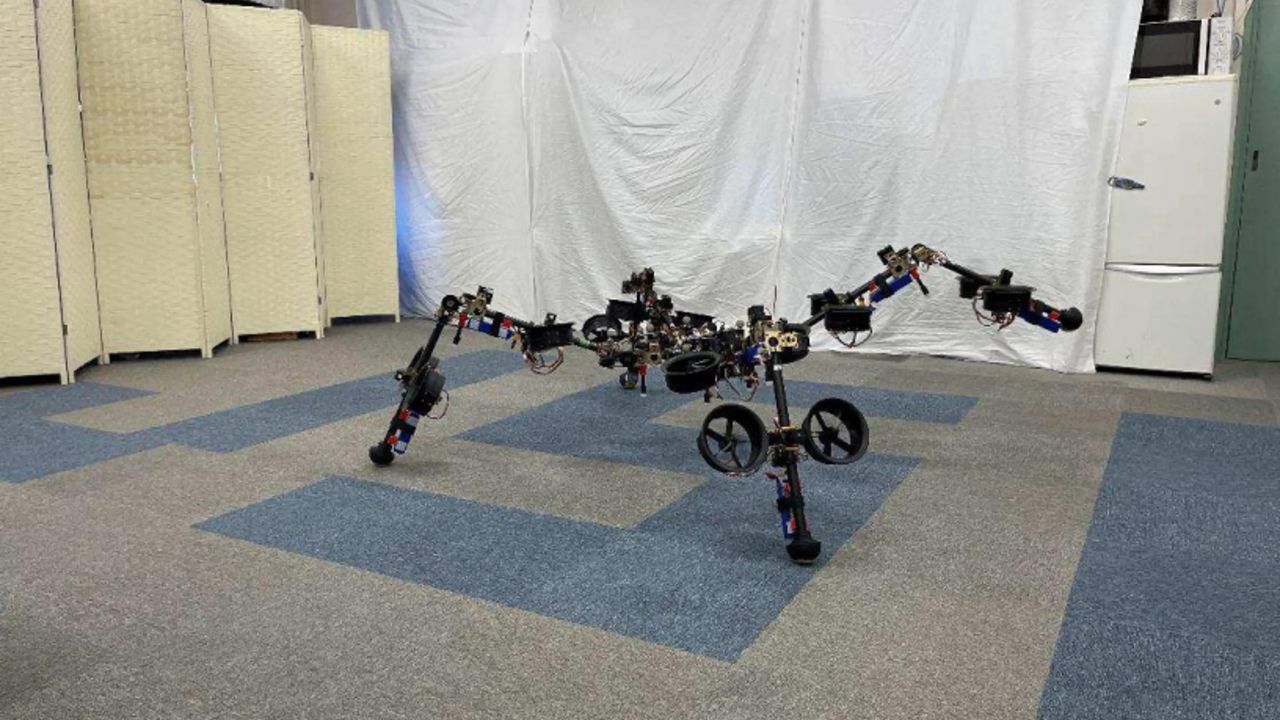Graduate students at the University of Tokyo have outdone themselves and are changing the way we look at drones forever with their newest invention. They created a group of futuristic-looking drone prototypes that can change their structural shape mid-air. As you will see in the video below, this could be a game changer if the drones were to be used by companies or the military for moving and transporting things.

How were these drones built?
The students were inspired by the idea of a dragon flying through the air, as we’ve seen in movies like “Game of Thrones,” and how they can twist and turn their bodies as they fly.
The drones were built with multi-axis gimbal systems and have individual segments. In the simplest of terms – a multi-axis gimbal system is a device that uses motors and sensors to stabilize and control the movement of a camera or other mounted object along multiple axes. It typically consists of a base, which houses the motors and controls, and a platform that holds the camera or other equipment. Also, in this case, each segment has its multi-copter propulsion unit, which powers it and allows it to thrust in any direction.
The aircraft continually changes its structural shape while in motion, which is why it moves a bit slowly in the video above. However, as you can see, it can handle basic tasks such as pushing and pulling, and grabbing onto objects. So as you can imagine, the opportunities and potential practical applications for its use in the future are endless.
MORE: 5 DRONES EXPERT REVIEWED
How can these drones be used in the future?
This cutting-edge technology could change the future of drone technology and its use in the future. For instance, it could be used by a company like Amazon to move and transport its products. Or it could possibly be used for search and rescue to change its shape and navigate through narrow spaces or to grab onto objects to transport them or push debris aside to clear a path. Another use could be in agriculture to grab onto and pick fruits and vegetables. It also could help with space exploration and be used to create spacecraft that can adapt to different conditions in space. In addition, the military could use this tech to adapt to different terrain types, such as navigating through forests or over rough terrain.
The fact that the drones have the ability to change structural shape while in motion makes the possibilities for their use endless. It’s important to note that the University of Tokyo team is still working on perfecting the drones to try to make them move faster and have more flexibility in the future.
MORE: HOW DRONES ARE REVOLUTIONIZING FOOD DELIVERY BY TAKING TO THE SKIES

Credit: University of Tokyo
What other projects are the students working on?
The students have also recently created a prototype known as the SPIDAR, which stands for SPherIcally vectorable and Distributed rotors-assisted Air-ground amphibious quadruped Robo. We know it’s quite a mouthful.

Credit: University of Tokyo
Essentially, the SPIDAR is a quadruped robot with articulating joints at the hip and knee of each leg. The joints are meant to help the robot to move around. However, it still moves pretty weakly and slowly and can only walk for around 20 minutes and fly for about 9 minutes. The hope is that the students will continue to develop the prototype so that it can eventually hold and manipulate two objects at once.
Should we be concerned by this new drone technology?
With all new technology, it has its pluses and minuses. While the potential applications of these drones seem exciting and limitless, there are also potential downsides to consider.
One negative could be the potential for these drones to be used for malicious purposes, such as espionage or terrorism. Their ability to change shape and maneuver through tight spaces could be tough to detect and track. Another downside is the impact on jobs, particularly in agriculture, where these types of drones could replace human labor in tasks such as picking crops. I also have concerns about privacy and surveillance if they were to be used for unauthorized surveillance, infringing on your privacy rights.
I think it’s crucial that we consider these potential downsides as we explore the possibilities of this new technology. As this tech becomes available, I really believe it’s also important to work to develop regulations and policies that can help to mitigate any negative impacts.
What do you think of these drones so far? Let us know your thoughts.
Related:
- AI race cars replacing humans drivers? Autonomous car racing revs up
- Amazon’s self-driving car makes history with public relations road test success
🛍️ SHOPPING GUIDES:
KIDS | MEN | WOMEN | TEENS | PETS |
FOR THOSE WHO LOVE:
COOKING | COFFEE | TOOLS | TRAVEL | WINE |
DEVICES:
LAPTOPS | TABLETS | PRINTERS | DESKTOPS | MONITORS | EARBUDS | HEADPHONES | KINDLES | SOUNDBARS | KINDLES | DRONES |
ACCESSORIES:
CAR | KITCHEN | LAPTOP | KEYBOARDS | PHONE | TRAVEL | KEEP IT COZY |
PERSONAL GIFTS:
PHOTOBOOKS | DIGITAL PHOTO FRAMES |
SECURITY
ANTIVIRUS | VPN | SECURE EMAIL |
CAN'T GO WRONG WITH THESE:



